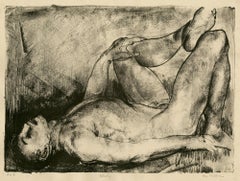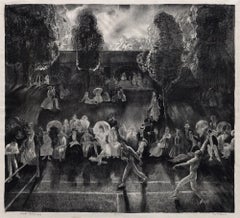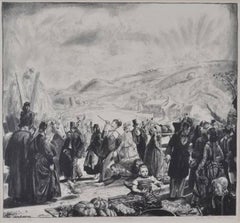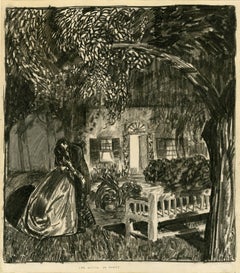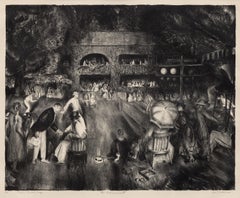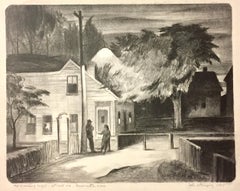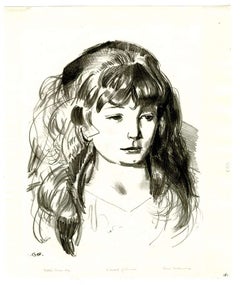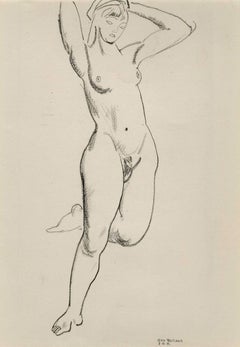George Wesley Bellows Art
American, 1882-1925
George Bellows, an American artist, was born in Columbus, Ohio in 1882, the only child of a successful building contractor from Sag Harbor, New York. He entered Ohio State University in 1901, where he played baseball and basketball and made drawings for college publications. He dropped out of college in 1904, went to New York, and studied under Robert Henri (American, 1865 – 1929) at the New York School of Art, where Edward Hopper (American, 1882 – 1967), Rockwell Kent (American, 1882 – 1971), and Guy Pène du Bois (American, 1884 – 1958) were his classmates. A superb technician who worked in a confident, painterly style, Bellows soon established himself as the most important realist of his generation. He created memorable images of club fights, street urchins swimming in the East River, and the Pennsylvania Station excavation site and garnered praise from both progressive and conservative critics.
In 1910 Bellows began teaching at the Art Students League and married Emma Story, by whom he had two daughters. After 1910 Bellows gradually abandoned the stark urban realism and dark palette characteristic of his early work and gravitated toward painting landscapes, seascapes, and portraits.
Bellows helped organize the Armory Show in 1913, in which five of his paintings and a number of drawings were included. That year he was elected a full member of the National Academy of Design. He had leftist political views and contributed illustrations to the Socialist publication The Masses from 1912 to 1917. Bellows began to make lithographs in 1916 and his exceptional talent engendered a revival of interest in the medium. He worked in Maine, in Carmel, California, and in Middletown, Rhode Island, and was a founding member of the Society of Independent Artists and a charter member of the Association of American Painters and Sculptors. In 1919 he taught at the Art Institute of Chicago.
Bellows, who never went to Europe, is regarded as a quintessential American artist whose vigorous style enabled him to explore a wide range of subjects from scenes of modern urban life to portraits of his daughters, to turbulent Maine seascapes. As an early biographer noted, Bellows “caught the brute force of the prizefighter, the ruggedness of the country pasture, the essence of childhood and recorded them appropriately not only for his own generation but for all time.”[1]
[1] [Frederick A. Sweet], George Bellows: Paintings, Drawings and Prints (Art Institute of Chicago, IL, 1946).
Robert Torchia September 29, 2016to
4
4
1
Overall Width
to
Overall Height
to
9
2
6
7
2
6
4
4
3
1
1
1
1
1
7
1
1
1
9
10,027
2,758
1,379
1,375
3
9
Artist: George Wesley Bellows
Man on His Back, Nude
By George Wesley Bellows
Located in Fairlawn, OH
Man on His Back, Nude
Lithograph, c. 1916
Signed by the artist lower right: Geo Bellows (see photo)
Annotated bottom left: No. 3 by the artist (see photo)
An unredorded trial proof b...
Category
1910s Ashcan School George Wesley Bellows Art
Materials
Lithograph
Tennis (Tennis Tournament)
By George Wesley Bellows
Located in Palm Desert, CA
A lithograph by George Bellows. “Tennis (Tennis Tournament)” is a realistic lithograph on paper in black and white by American Realist, George Bellows. Bellows’ depictions of sportin...
Category
1920s American Realist George Wesley Bellows Art
Materials
Lithograph
The Irish Fair
By George Wesley Bellows
Located in Fairlawn, OH
Irish Fair
Lithograph, 1923
Signed and numbered in pencil by the artist (see photo)
Titled "Irish Fair" by the artist in pencil
Edition: 84
Housed in an archival frame with acid free matting (see photo)
Provenance:
Estate of the artist, Bellows Family Trust
H.V. Allison & Company (label)
Private Collection, Columbus
References And Exhibitions:
Reference: Mason 153
Note: An illustration commissioned by The Century Company for Don Byrne's novel The Wind Bloweth
Image: 18 7/8 x 21 3/8"
Frame: 29 1/2 x 30 1/2"
“Eleven on a hot July morning, and the little town...
Category
1920s Ashcan School George Wesley Bellows Art
Materials
Lithograph
The Mouth of Honey
By George Wesley Bellows
Located in Fairlawn, OH
The Mouth of Honey
Lithographic crayon and mixed media on paper mounted to support paper
Initialed by the artist "GB" bottom center on image. (see photo)
Titled in pencil in bottom m...
Category
1920s Ashcan School George Wesley Bellows Art
Materials
Crayon
PUNCHINELLO IN THE HOUSE OF DEATH.
By George Wesley Bellows
Located in Portland, ME
Bellows, George (American 1882-1925). PUNCHINELLO IN THE HOUSE OF DEATH.Mason 151 Lithograph, 1923. Edition of 60. Titled and signed in pencil by Bellows, and also signed "Bolton Bro...
Category
1920s George Wesley Bellows Art
Materials
Lithograph
The Tournament (Tennis at Newport)
By George Wesley Bellows
Located in Palm Desert, CA
A lithograph by George Bellows. “The Tournament (Tennis at Newport)” is a realistic lithograph on paper in black and white by American Realist artist, George Bellows. Bellows' depictions of sporting / leisure scenes are unique and valuable. This artwork is edition 56/63 with framed dimensions of 26 x 29 x 1 1/4 inches and has been in the same private collection for almost four decades. The artwork is signed in pencil, lower right, "G. Bellows.”
Provenance:
Catherine E Burns...
Category
1920s American Realist George Wesley Bellows Art
Materials
Lithograph
The Hold Up, First State
By George Wesley Bellows
Located in Fairlawn, OH
Signed in pencil by the artist lower right
Titled "Hold Up" by the artist in pencil.
Signed by the printer Bolton Brown lower left.
Edition: 42 in this state
Note: In The Hold Up, se...
Category
1920s American Realist George Wesley Bellows Art
Materials
Lithograph
red ballboy or Studies for "Tennis Tournament"
By George Wesley Bellows
Located in Fairlawn, OH
Red Ballboy or Studies for "Tennis Tournament"
Crayon on paper, c. 1920
Unsigned
Condition: three vertical folds created by the artist to transport the drawing from the tennis match ...
Category
1910s Ashcan School George Wesley Bellows Art
Materials
Graphite
THE LIFE CLASS - SECOND STONE (THE MODEL, LIFE CLASS).
By George Wesley Bellows
Located in Portland, ME
Bellows, George. THE LIFE CLASS - SECOND STONE (THE MODEL, LIFE
CLASS). Mason 43, Bellows 193. Lithograph, 1917. Edition of 49,
signed by Bellows. Inscribed "No.20," titled and sign...
Category
Early 20th Century George Wesley Bellows Art
Materials
Lithograph
Related Items
John W. Gregory, Approaching Night, Atwood Avenue, Provincetown, MA
By John W. Gregory
Located in New York, NY
Gregory worked mostly in lithography, probably learned at the Art Students League in New York City. However he often drew New England subjects, so this evening Provincetown scene is ...
Category
1930s Ashcan School George Wesley Bellows Art
Materials
Lithograph
MB 053 (Figurative Charcoal Drawing of a Muscular Male Nude on Arches Paper)
By Mark Beard
Located in Hudson, NY
Figurative male nude drawing made of graphite, charcoal, and conte crayon on Arches paper
30 x 20 inches, unframed
This unique life study drawing of a standing male nude was made...
Category
2010s Modern George Wesley Bellows Art
Materials
Charcoal, Crayon, Graphite
Put Fighting Blood in Your Business
Located in Spokane, WA
Original WW1 poster. Put Fighting Blood in Your Business. Here’s his record! Does he get a Job? Arthur Woods, Assistant to the Secretary of...
Category
1910s American Realist George Wesley Bellows Art
Materials
Lithograph
Joseph Webster Golinkin, On the Dock, Banana Boat, New Orleans
By Joseph Webster Golinkin
Located in New York, NY
Chicago-born Golinkin studied at the Artist Students League with George Luks. After working as an illustrator for New York papers he joined the Navy in 1939 and retired as a Rear Adm...
Category
1930s Ashcan School George Wesley Bellows Art
Materials
Lithograph
$1,200
H 14.5 in W 13.25 in
Marc Chagall - Double Portrait - Original Lithograph
By Marc Chagall
Located in Collonge Bellerive, Geneve, CH
Marc Chagall, Original Lithograph depicting an instant of the Bible.
Technique: Original lithograph in colours
Year: 1956
Sizes: 35,5 x 26 cm / 14" x 10.2" (sheet)
Published by: Édit...
Category
1950s Modern George Wesley Bellows Art
Materials
Lithograph
$1,555
H 13.98 in W 10.24 in D 0.04 in
after Henri Matisse - Acrobat
By Henri Matisse
Located in Collonge Bellerive, Geneve, CH
after Henri Matisse - Acrobat
Edition of 200
with the printed signature, as issued
76 x 56
With stamp of the Succession Matisse
References : Artvalue - Succession Matisse
Category
1950s Modern George Wesley Bellows Art
Materials
Lithograph
Andrew Wyeth, New Leaves, from The Four Seasons (after)
By Andrew Wyeth
Located in Southampton, NY
This exquisite lithograph after Andrew Wyeth (1917–2009), titled New Leaves, originates from the distinguished 1962 folio The Four Seasons: Paintings and Drawings by Andrew Wyeth. Published and printed by Art in America Company, Inc., New York, the edition exemplifies Wyeth’s quiet observation of nature and the passage of time. New Leaves captures the delicate stir of spring renewal—the subtle emergence of life in the landscape—rendered with Wyeth’s hallmark balance of precision, restraint, and emotional depth.
Executed on velin paper, this lithograph measures 17 x 13 inches (43.2 x 33 cm). As issued, it is unsigned and unnumbered, representing the folio’s authentic format. The Four Seasons series was conceived by the editors of Art in America in collaboration with Andrew and Betsy Wyeth, who selected drawings from the artist’s studio and personal archive to embody the poetic rhythm of the changing seasons. Each composition reveals Wyeth’s mastery of atmosphere, mood, and the quiet intensity of natural experience.
Artwork Details:
Artist: After Andrew Wyeth (1917–2009)
Title: New Leaves, from The Four Seasons, Paintings and Drawings by Andrew Wyeth, 1962
Medium: Lithograph on velin paper
Dimensions: 17 x 13 inches (43.2 x 33 cm)
Inscription: Unsigned and unnumbered, as issued
Date: 1962
Publisher: Art in America Company, Inc., New York
Printer: Art in America Company, Inc., New York
Condition: Well preserved, consistent with age and medium
Provenance: From the 1962 folio The Four Seasons, Paintings and Drawings by Andrew Wyeth, published and printed by Art in America Company, Inc., New York
Notes:
Excerpted from the 1962 folio:
"In 1962 the editors of Art in America proposed to Wyeth a portfolio of images of his recent dry-brush drawings. The artist and his wife suggested the theme, 'The Four Seasons,' because of the essential role played in his work by the cycle of the seasons. The drawings were selected by Andrew and Betsy Wyeth from works in the house and studio at Chadds Ford, supplemented by some owned by friends. With a few exceptions they had never been exhibited or reproduced. The plates were made directly from the originals. In these drawings Wyeth's loving concentration on the object is fully revealed. But as always in his work, this concern with the tangible is balanced by sensibility to mood, to the emotion arising from the actual. They are pervaded with a sense of the season—the exact time of year, the hour of the day, the quality of the light. To the truth and subtlety with which he captures these intangible factors, these drawings owe their poignant poetry."
About the Artist:
Andrew Wyeth (1917–2009) was an American visual artist and one of the best-known painters of the mid-20th century. Although he considered himself an abstractionist, Wyeth’s work is characterized by a meticulous realism imbued with psychological depth and atmosphere. He often painted the landscapes and people surrounding his homes in Chadds Ford, Pennsylvania, and Cushing, Maine, creating an intimate record of American rural life. The son of the celebrated illustrator N. C. Wyeth, Andrew trained under his father before developing his own deeply personal visual language inspired by Winslow Homer, Henry David Thoreau, and King Vidor. His wife, Betsy Wyeth, was both his muse and career manager, while his son Jamie Wyeth continued the family’s artistic legacy.
Among Wyeth’s best-known works is Christina’s World (1948), housed in the Museum of Modern Art, New York—a quintessential image of 20th-century American art. His other notable series include The Helga Pictures and his window studies, each reflecting a profound meditation on solitude, memory, and perception. Wyeth was the first painter to receive both the Presidential Medal of Freedom and the Congressional Gold Medal, and was elected to the French Académie des Beaux-Arts in 1980.
In 2022, Andrew Wyeth's painting Day Dream sold for USD 23.29 million at Christie’s New York, setting a world record for the artist.
Andrew Wyeth lithograph...
Category
1960s American Realist George Wesley Bellows Art
Materials
Lithograph
Native Mexican Woman (Cuban Miami artist pastel)
Located in Wilton Manors, FL
Alex (Cuban, b.1949). Indigenous Mexican Woman, 1982. Pastel and charcoal on wove paper, sheet measures 23 x 33 inches. 31 x 40.5 inches on backing board...
Category
1980s Modern George Wesley Bellows Art
Materials
Paper, Charcoal, Pastel
'Plowing It Under' — WPA Era American Regionalism
By Thomas Hart Benton
Located in Myrtle Beach, SC
Thomas Hart Benton, 'Goin' Home', lithograph, 1937, edition 250, Fath 14. Signed in pencil. Signed in the stone, lower right. A fine, richly-inked impression, on off-white, wove pape...
Category
1930s American Realist George Wesley Bellows Art
Materials
Lithograph
“Untitled (Women Walking), c. 1945” Double-Sided NYC Street Manhattan Cityscape
By Reginald Marsh
Located in Yardley, PA
A fantastic example of Marsh’s renowned depictions of ladies walking in downtown Manhattan. This richly worked ink and wash composition captures a sidewalk populated by stylish women...
Category
Mid-20th Century Ashcan School George Wesley Bellows Art
Materials
Paper, Ink, Watercolor
$6,500
H 31.75 in W 39.38 in D 1.25 in
Irving Guyer, Roll Them Bones, Depression-era African-American men at craps
By Irving Guyer
Located in New York, NY
An American Depression-Era subject of African-American men playing craps by Irving Guyer.. (Craps is a game of chance that required neither skill nor strategy. The object is to predi...
Category
1930s Ashcan School George Wesley Bellows Art
Materials
Etching
Yelding the Right of Way
Located in San Francisco, CA
This artwork titled "Yelding the Right of Way" c.1975 is a color offset lithograph by renown western artist Arnold Friberg, 1913-2010. It is hand signed...
Category
Late 20th Century American Realist George Wesley Bellows Art
Materials
Lithograph
Previously Available Items
Sketch of Anne
By George Wesley Bellows
Located in Fairlawn, OH
Sketch of Anne
Lithograph, 1923-1924
Signed and titled by the artist, signed by his printer Bolton Brown
Edition: 42
Printed by Bolton Brown (see photo of his signature in pencil)
Pr...
Category
1920s Ashcan School George Wesley Bellows Art
Materials
Lithograph
Standing Female Nude
By George Wesley Bellows
Located in Fairlawn, OH
Standing Female Nude
Graphite on wove paper, c. 1915
Signed by the artist's daughter, Jean Bellows Booth (JBB) (see photo)
Provenance:
Estate of the artist
H. V. Allison Galleries (#94 on partial label), agent for Bellows Trust
Ronald Sloter, Columbus, OH, noted collector
Columbus College of Art and Design
Biography
George Wesley Bellows grew up in Columbus, Ohio, the son of a devout and solidly Midwestern building contractor, and a mother who hoped that her son would become a Methodist Bishop. He always felt deeply ambivalent about his father, noting at the time of his death that, "He was a wonderfully fine man, yet being fifty-five when I appeared, his point of view, his character even, belonged to so remote a past that I look upon many of his ideas to this day with amazement and sorrow."
Teased as a sissy by his classmates, George Bellows quickly learned to defend himself with his fists, and compensated for his gangling awkwardness by becoming an outstanding athlete, particularly in baseball. His love of drawing was kindled early since he was forbidden to play outside on Sundays but allowed to draw while his mother read aloud from the Bible.
At Ohio State University, George Bellows proved a spirited extrovert, excelling in baseball as well as in the new sport of basketball, singing in theatricals, and producing drawings of Gibson-like girls for the university's magazine. Bellows's athletic prowess almost diverted him from a career in art, but in 1904 he decided to turn down a professional baseball contact and move to New York City to study painting.
The sprawling, teaming city of New York was a revelation to him after the neat lawns and tidy homes of Columbus. There he quickly fell under the spell of the charismatic teacher Robert Henri, who introduced him to Shaw, Ibsen and socialism, and inspired him to shift from drawing Gibson Girls to painting the life of the streets. Bellows was still a relative newcomer to New York when Henri and his followers staged their famous exhibition of "The Eight" at the Macbeth Gallery, and consequently he was not included. But in spirit his work belongs with that display - perhaps someday Henri’s group will be rechristened "The Nine" to pay tribute to the fact that George Bellows was the painter whose work best expresses the goals of the group.
In 1906 Bellows painted his first masterpiece, "The Cross-Eyed Boy." He followed with several other equally memorable likenesses of street urchins, and then expanded his vision with a series of masterful urban scenes that record such subjects as boys swimming...
Category
1920s Ashcan School George Wesley Bellows Art
Materials
Graphite
Emma and Marjorie on a Sofa
By George Wesley Bellows
Located in Fairlawn, OH
Emma and Marjorie on a Sofa
Lithograph printed on chine paper, 1921
Signed by the artist lower right (see photo)
Signed by the printer Bolton Brown lower left (see photo)
Edition: 44...
Category
1920s Ashcan School George Wesley Bellows Art
Materials
Lithograph
Hungry Dogs, Second State
By George Wesley Bellows
Located in Fairlawn, OH
Hungry Dogs, Second State
Lithograph, 1916
Considered to be the artist's first lithograph
Signed, titled and numbered in pencil by the artist (see photo)
Titled "Hungry Dogs" by the artist in pencil (see photo)
Edition: at least 41 impressions, this "No. 14"
Reference: Masson 1B ii/II
Condition: Printer's ink in margins, otherwise very good condition.
Note: The artist's first lithograph. The "Ash Can School" is derived from this image and its' depiction of an ash can in the lower left of the composition. A very important American 20th Century print. This image gave rise to the naming of the most important American style of painting in the first quarter of the 20th century.
Provenance: Estate of the artist
H. V. Allison & Co., New York (Bellows estate dealer)
Private Collection, Columbus, Ohio (Bellows city of birth)
From 2001 to 2018, Thomas French Fine Art was the exclusive agent for the Bellows Family Trust. Thomas French Fine Art and The Bellows Trust hold a large inventory of original lithographs and drawings created by George Wesley Bellows that were left in the artist’s studio at the time of his unexpected early death. All of George Bellows’ original lithographs were printed by the artist or under his direct supervision. There are no posthumous impressions of any of George Bellows’ lithographs...
Category
1910s American Realist George Wesley Bellows Art
Materials
Lithograph
BETWEEN ROUNDS
By George Wesley Bellows
Located in Portland, ME
Bellows, George (American 1882-1925). BETWEEN ROUNDS NO.1 (LARGE). Mason 25, Bellows 52. Lithograph, 1916.
Edition of 58, this signed by Jean Bellows Beeth, the artist's daughter, a...
Category
1910s George Wesley Bellows Art
Materials
Lithograph
ARTIST'S EVENING (AT PETIPAS)
By George Wesley Bellows
Located in Portland, ME
Bellows, George. ARTIST'S EVENING (AT PETIPAS). M.19. Lithograph, 1916. Edition of 65. A lifetime impression, signed by the artist in pencil and numbered "57." Printed on thin Japane...
Category
Early 20th Century American Modern George Wesley Bellows Art
Materials
Lithograph
Between Rounds, Small, Second Stone
By George Wesley Bellows
Located in Fairlawn, OH
Signed and titled by the artist
Signed lower left by the printer, Bolton Brown
Edition 42
Printed on fine chine paper, mounted to paper board, most probably by the artist’s first print dealer, Frederick Keppel & Company, in the mid 1920’s. This is consistent with other similar mounted examples in the estate of the artist. The Keppel firm was active from 1868 to 1941, when Harry V. Allison started his own gallery, H. V. Allison Gallery...
Category
1920s Ashcan School George Wesley Bellows Art
Materials
Lithograph
The Black Hat (Emma in a Black Hat)
By George Wesley Bellows
Located in New York, NY
George Bellows (1882-1925), The Black Hat (Emma in a Black Hat), lithograph, 1921. Reference: Morse 113. From the edition of 55. Signed in pencil by the arti...
Category
1920s American Realist George Wesley Bellows Art
Materials
Lithograph
Preliminaries (to the Big Bout).
By George Wesley Bellows
Located in Storrs, CT
Mason 24. 15 7/8 x 19 5/8 (sheet 23 x 27 1/4). Edition 67, #2. A rich impression printed on white wove paper paper, with full margins. Provenance: ACA Galleries, private New York collection. This is a fine lifetime impression. Signed, numbered and titled in pencil by the artist.
In this early impression, there are four spotlights in the top of the image. The three in the right were eliminated in subsequent impressions.
-----------------------------------------------------------------------------------------
Bellows...
Category
20th Century Ashcan School George Wesley Bellows Art
Materials
Lithograph
Sixteen East Gay Street
By George Wesley Bellows
Located in Fairlawn, OH
Signed by the artist and his printer Bolton Brown
Edition: 72
Provenance:
H.V. Allison & Co., Inc., New York (label)
References And Exhibitions:
This nostalgic scene o...
Category
1920s George Wesley Bellows Art
Materials
Lithograph
Legs of the Sea
By George Wesley Bellows
Located in Fairlawn, OH
Signed by the artist and his printer Bolton Brown
Edition: 53
Provenance:
H.V. Allison & Co., Inc., New York (label)
References:
Lauris Ma...
Category
1920s George Wesley Bellows Art
Materials
Lithograph
Top I' the World
By George Wesley Bellows
Located in Fairlawn, OH
Signed by the artist lower right "G.B."
Preliminary drawing for the frontispiece illustration of The Wind Bloweth by Donn Byrne
Exhibited:
Gallery of Modern Art, 1966
A C...
Category
1920s George Wesley Bellows Art
Materials
India Ink, Oil Crayon
George Wesley Bellows art for sale on 1stDibs.
Find a wide variety of authentic George Wesley Bellows art available for sale on 1stDibs. You can also browse by medium to find art by George Wesley Bellows in lithograph, graphite, pencil and more. Not every interior allows for large George Wesley Bellows art, so small editions measuring 8 inches across are available. Customers who are interested in this artist might also find the work of Fred Nagler, Frank Benson, and John Sloan. George Wesley Bellows art prices can differ depending upon medium, time period and other attributes. On 1stDibs, the price for these items starts at $3,500 and tops out at $55,000, while the average work can sell for $7,800.
Artists Similar to George Wesley Bellows
Questions About George Wesley Bellows Art
- 1stDibs ExpertApril 5, 2022George Bellows created paintings that focussed on realism. His oil paintings mixed urban studies with social and political themes, mainly centered around New York City. On 1stDibs, you can shop a selection of George Bellow’s pieces from some of the world’s top art dealers from the comfort of your home.
- 1stDibs ExpertApril 5, 2022Cliff Dwellers by George Bellows is a painting created in 1913 that’s meant to depict the explosive population growth that New York City was experiencing at the time. Specifically, the painting is of a hot summer’s day in New York City’s Lower East Side. On 1stDibs, find a variety of original artwork from top artists.
